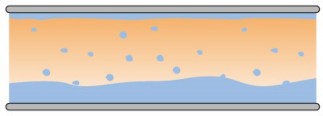-
Basic Knowledge of Steam
-
Two-phase gas-liquid flow of steam and condensate
-
At the end of this chapter, we briefly describe the flow of steam and condensate in one line. If both the gas phase and the liquid phase exist in the same flow path, then the flow is called ‘gas-liquid two-phase flow’, or just a ‘two-phase flow’. Examples are listed below.
In the case of gas-liquid two-phase flow of steam and condensate, it is easy to assume that the denser condensate flows at the bottom of the line and the lighter, higher velocity steam flows at the top.. This, however, may not be true for steam / condensate, where the actual position and flow in the line may depend on various variables such as flow velocity.
In general, the recommended steam flow velocity in a steam transport line is from 20m/s to 40m/s. According to the same handbook, the condensate flow under this steam velocity becomes an annular flow or an annular spray flow as shown in Figure 1.6. Even in a horizontal line, it flows in such a way that it makes contact with not only the bottom of the inside of the line but also its sides and top.

Figure 1.6 annular flow of condensate
There are branch lines in the steam transportation line at certain intervals in order to discharge the condensate from the bottom of the lines. However, it is impossible to discharge all condensate because it is difficult to remove the generated condensate. Thus, it should be considered that there is already some moisture in the steam when it comes to its place of use. MIYAWAKI, Inc. strongly recommends that a separator be installed in front of the steam equipment.